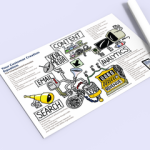Monopoly is the quintessential game of American capitalism. For better or worse, it focuses the player on one goal: maximizing the number of dollars in your pile. Everyone has their own strategy and their preferred properties to own and build. Your little sister may only buy properties if she likes the color.
Excellent monopoly players learn their opponents’ strategy and then adapt to respond to the environment they are in.
If you look beyond the “greed is good” focus on money, you will realize that playing the game teaches the principles of scarcity and optimization.
The number dollars you start with is scarce. You must make the most of your limited resources.
You want to be ready when lady luck glances your way. When a dog, a car, or a hat finally lands your property, you better be ready.
Running a business website is no different. You inevitably have scarce resources to spend building the site and attracting traffic.
And when those visitors finally land on your site, you better be ready. This is the job of optimization.
If you viewed your web page as a Monopoly board, would it change your priorities and behavior?
Like houses and hotels, would the right elements be on your page be there?
Too often, we don’t think about our web pages as scarce resources that have to be optimized. Too often, we use our little sister’s “pretty property” strategy. Trust me. She still hates to lose.
Scarcity
In Monopoly, we can’t own all the properties and have hotels on all properties. We have to deal with scarcity. Our money supply is limited, as is our opportunity to buy properties. The desire to compete brings out our analytical nature and we scheme to make the most of the resources we have as opposed to the resources we want. We do this because we know we have an opponent that is actively working to undo us. Again, do we think about our web page the same way?
In reality, we do have opponents in our web strategy. Not just one, but many. In fact, we usually have more opponents than competitors. Some of these opponents include:
- Limited attention span
- Lack of common reference and knowledge base
- Low-resolution computer monitors
- Negative emotional association with specific words or images
- Slow connection speeds
As you think about the opponents listed above, you will recognize scarcity working against your ultimate goal. Vigorously compete against these opponents on your site with the same vigor you compete in Monopoly, and you’ll be more likely to “pass GO and collect $200.”
Optimization
Something amazing happens on the Monopoly board that doesn’t naturally happen on our web page. [pullquote position=”right”]In Monopoly, we quit caring about how glamorous a property is and instead focus on how much money it will make for us.[/pullquote] In contrast, it is the very rare individual who walks into a web planning meeting without being focused on making the most beautiful page possible. If we played Monopoly the same way, we would focus on acquiring and building hotels on Boardwalk and Park Place and be done. If you try this approach, either in Monopoly or on your website, you lose.
If you don’t pull your weight, you’re gone!
Without emotion, we require properties to pay their way. They have a job to do and we expect them to do it well. The properties’ job is generating revenue.
Is there an element on your web page that isn’t pulling its weight? As optimizers, our job is to identify the converting elements on a page and remove the non-converting elements.
Testing to see which properties are performing
Such was the case for one client’s site, when we set out to improve the home page. We followed this process to find out which elements led to conversions:
1. We set up Google to score on bounce rate while watching conversions.
2. We used click-tracking software heat mapping to identify content that was not getting clicked. This website has 4 clickable icons that take the user to additional content. We found that the 2 outer icons had low activity and decided to test them against alternate icons.
3. The experiment executed quickly with the following results:
- 10% improvement in bounce rate
- 56% improvement in conversions
That felt good – let’s do it again
After experiencing success, it seemed like a good idea to try again. This time we identified one icon that was under-performing, so we replaced it with another one that led to a converting page. The result here is interesting. Looking at the heat map alone indicates the replaced icon is more desirable. But looking at the numbers reveals it was not the right choice.
As shown on the heat map above, replacing the 3rd icon attracted many more clicks on the “B” version of the page. However, both the bounce rate and the conversion rate took a hit.
- Bounce rate degraded 4%
- Conversion rate decreased 56%
This experiment shows why it is essential to test and scrutinize the results. Two nearly identical hypotheses with two nearly identical changes led to opposite results. My initial inclination was to ignore the results and push the change through. But I put on my Monopoly head and determined the measurable results of the change should trump how I felt about the change.
No Experiment is a Failure
It would be easy to walk away from the second experiment and view it as a total loss. In the same way that losses are our teachers in Monopoly, losses should be our teachers in web optimization experiments. Just as every Monopoly opponent is unique, our clients and website visitors are unique.
To better understand the behavior we observed, we sought to learn more by asking some basic questions:
- Why did higher clicks on the replaced icon also correspond to a higher bounce rate? (Hint: something else didn’t get clicked as much!)
- What was appealing about the new icon?
- Why did the site conversion rate drop?
- What was the net gain/loss of each individual conversion metric?
- Did the new copy corresponding to the new icon have a negative impact?
- Would alternate copy change the site performance?
- Did the new icon and copy add clarity and relevance?
- Did the new icon and copy add anxiety or distraction?
It is important to learn from each experiment regardless of the results. Applying this discipline is critical in understanding the unique functionality of your website and what increases or decreases conversions. [pullquote position=”right”]Failing to learn from a “failed” experiment is like failing to learn the tactics of your Monopoly opponent. You will face them again, and you want to be prepared when you do.[/pullquote]
So What Should You Do?
Like many 12-step programs, the first step is to acknowledge you have a problem. Say out loud, “I care more about how pretty my web page is than how much money it makes.” Let that sink in and prepare to change. Make a personal commitment to website profitability based on hard data. Then approach your web pages with the kind of profit-focused attention to scarcity and optimization that wins Monopoly games.
- Make a list of the individual components on your web page – especially above the fold.
- Write the purpose of each component next to it.
- Ask yourself if each component contributes to profit – and eliminate those that don’t.
- Ask yourself if there is anything that could replace the existing components that would drive more profit.
- Test, test, test.
Nobody is immune to personal biases and individual favorites. If you want to maximize the functionality of your website, you need to put a structure in place that always tests and always trusts data over opinion. When you make a habit of doing that, you will be the same formidable opponent that you are in Monopoly.
About the Author
 Craig Andrews is the Principal Ally and founder of internet marketing agency allies4me. Andrews brings extensive scientific and marketing expertise to allies4me. Over the last 25 years, his experience has spanned search engine optimization, internet marketing software, biomedical and semiconductors. Andrews is backed by a team of marketing allies who support start-ups to Fortune 500 companies.
Craig Andrews is the Principal Ally and founder of internet marketing agency allies4me. Andrews brings extensive scientific and marketing expertise to allies4me. Over the last 25 years, his experience has spanned search engine optimization, internet marketing software, biomedical and semiconductors. Andrews is backed by a team of marketing allies who support start-ups to Fortune 500 companies.
In recent years, clients have been seeking guidance from allies4me on Social Media strategies. Rather than jumping on the latest hype, Andrews sought to understand Social Media through solid metrics across large data sets. The result is an unconventional and insightful approach to Social Media. Testing and data driven decisions advise all areas of allies4me work. Solid metrics and disciplined parsing of data is where allies4me clients find results.
You can connect with Craig Andrews on Google+ and LinkedIn. You can find allies4me on LinkedIn,Google+, Facebook, and Twitter.










